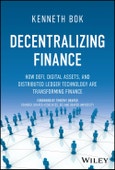A Practitioner's Guide to Decentralized Finance (DeFi), Digital Assets, and Distributed Ledger Technology
In Decentralizing Finance: How DeFi, Digital Assets and Distributed Ledger Technology Are Transforming Finance, blockchain and digital assets expert Kenneth Bok offers an insightful exploration of the current state of decentralized finance (DeFi). As distributed ledger technology (DLT) increasingly optimizes and democratizes financial ecosystems worldwide, this book serves as a comprehensive guide to the most salient aspects of the ongoing transformation.
The text delves into both crypto-native DeFi and DLT applications in regulated financial markets, providing:
- Comprehensive analysis of crypto-native DeFi across key areas such as its competitive landscape, infrastructure, financial instruments, activities, and applications
- Coverage of key risks, mitigation strategies, and regulatory frameworks, analyzed through the perspective of international financial standard-setting bodies
- Insight into how DLT is reshaping traditional financial systems through innovations like central bank digital currencies (CBDCs), tokenized assets, tokenized deposits, and institutional-grade DeFi platforms
In a world where financial technology is rewriting the fundamental code of digital currency, the future of money is undeniably DLT-centric. How will this seismic shift interact with existing financial infrastructures? Can decentralization and traditional banking coexist and potentially synergize? This book endeavors to answer these pressing questions for financial professionals navigating these transformative times.
Authored by a former Goldman Sachs trader, past Head of Growth at Zilliqa, and an early Ethereum investor with extensive experience in both traditional finance and the crypto ecosystem, Decentralizing Finance provides you with an insider's perspective on the revolution that is DeFi.
Table of Contents
Acknowledgmentsxiii
Glossary xv
Foreword xvii
Introduction 1
I 1 Who Am I? 2
I 2 How This Book Is Organized 3
I 3 Scope of This Book 4
I 4 Disclaimers 5
I 5 Corrections 5
Part I Crypto-native DeFi 7
1 What Is DeFi? 9
1.1 The Role of Intermediaries in TradFi 12
1.2 Definitions 13
1.3 Other Characteristics of DeFi 15
1.4 The DeFi Stack 16
1.5 Size of DeFi 18
1.6 Key Participants in DeFi 19
1.7 DeFi and FinTech 25
1.8 How Can I Try DeFi? 27
1.9 Where Does DeFi Meet TradFi? 28
1.10 What Are the Risks of DeFi? 30
1.11 Chapter Summary 31
2 Infrastructure and Instruments 33
2.1 The Infrastructure of DeFi 33
2.2 Basics of Blockchains 34
2.3 Bitcoin and Ethereum 38
2.4 Permissioned vs Public Blockchains 39
2.5 L1s and L2s 41
2.6 Accounts, Keys, Wallets, and Addresses 44
2.7 Transactions 46
2.8 Smart Contracts 48
2.9 Clients and Nodes 49
2.10 Block Explorers 50
2.11 Custody 50
2.12 Oracles 52
2.13 RegTech 52
2.14 Identity 52
2.15 Bridges 52
2.16 DeFi Instruments 53
2.17 Stablecoins 55
2.18 Derivatives 60
2.19 Chapter Summary 61
3 Activities and Applications 63
3.1 Trading / DEXs 63
3.2 Overcollateralized Lending / Borrowing 66
3.3 Governance / DAOs 70
3.4 Undercollateralized Lending 72
3.5 Investing 82
3.6 Payments 84
3.7 Insurance 89
3.8 Prediction Markets 91
3.9 Chapter Summary 92
4 Risks and Mitigation 95
4.1 Types of Losses 96
4.2 Basic Terminology 96
4.3 Endogenous DeFi Risks 97
4.4 Exogenous DeFi Risks 104
4.5 Chapter Summary 118
5 Regulation 121
5.1 Introduction 121
5.2 Global Nature of Crypto and DeFi 122
5.3 What Regulators Want 124
5.4 Are Tokens Securities? 125
5.5 The Travel Rule 126
5.6 Prudential Treatment of Crypto-asset Exposures 128
5.7 SSBs, United States and European Union 131
5.8 European Union - MiCA 136
5.9 United States 140
5.10 DeFi Specific Regulation 143
5.11 Chapter Summary 147
Part II DLT in Traditional Finance 151
6 Central Bank Digital Currencies 153
6.1 Introduction 153
6.2 Prologue: Libra 155
6.3 Role of the Central Bank 156
6.4 Structure of the Monetary System and a View Towards the Future 157
6.5 Central Bank Motivations and Considerations around CBDCs 158
6.6 Retail vs Wholesale CBDCs 159
6.7 Wholesale CBDCs 159
6.8 Case Study: Project mBridge 163
6.9 Retail CBDCs 165
6.10 Benefits and Risks of R-CBDCs 167
6.11 R-CBDC Design Choices 170
6.12 Types of R-CBDCs 174
6.13 Examples of R-CBDCs 177
6.14 Case Study: Nigerian eNaira 178
6.15 Case Study: United States 179
6.16 Case Study: eCNY 数字人民币 181
6.17 Chapter Summary 184
7 Asset Tokenization 187
7.1 What Is Asset Tokenization? 187
7.2 Benefits of Asset Tokenization 189
7.3 How is Tokenization Performed? 192
7.4 Considerations for Tokenization 193
7.5 DLT in Capital Markets 194
7.6 Asset Servicing 198
7.7 Chapter Summary 200
8 Deposit Tokens 203
8.1 What Are Deposit Tokens? 203
8.2 Benefits of Deposit Tokens 205
8.3 Deposit Token Projects 206
8.4 Chapter Summary 211
9 Institutional DeFi 213
9.1 Considerations for Institutions to Participate in DeFi 213
9.2 Institutional DeFi Examples 214
9.3 AMMs and FX 218
9.4 Considerations for AMMs and Tokenized Assets 220
9.5 Unified Ledger 221
9.6 Chapter Summary 222
10 Conclusion 225
10.1 The Crypto-Fiat Innovation Dialectic 226
10.2 Future Scenarios for DeFi: The Wild West, the Citadel, and the Bazaar 231
10.3 The Future of Money 236
Bibliography and Online Resources 241
Index 243








